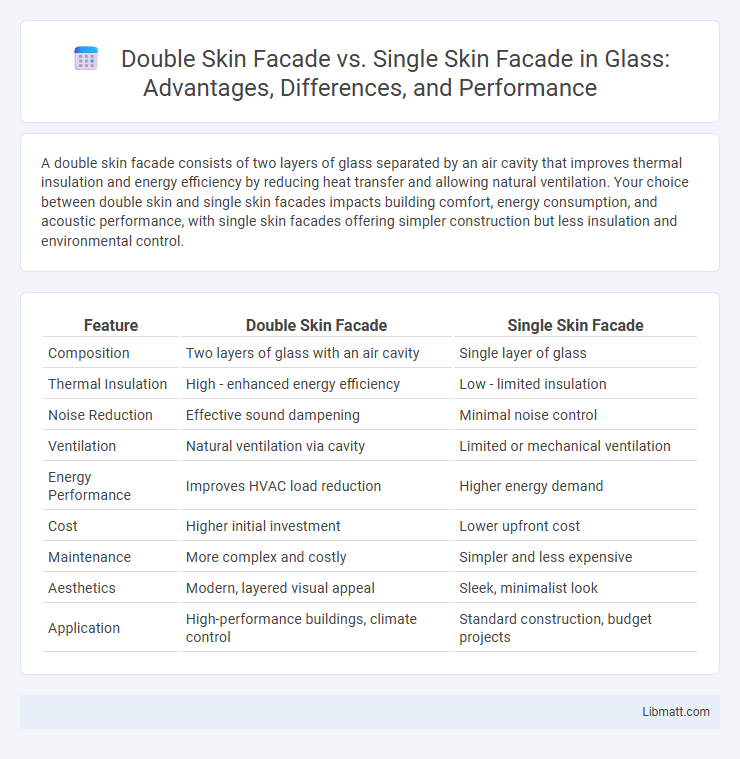A double skin facade consists of two layers of glass separated by an air cavity that improves thermal insulation and energy efficiency by reducing heat transfer and allowing natural ventilation. Your choice between double skin and single skin facades impacts building comfort, energy consumption, and acoustic performance, with single skin facades offering simpler construction but less insulation and environmental control.
Table of Comparison
| Feature | Double Skin Facade | Single Skin Facade |
|---|---|---|
| Composition | Two layers of glass with an air cavity | Single layer of glass |
| Thermal Insulation | High - enhanced energy efficiency | Low - limited insulation |
| Noise Reduction | Effective sound dampening | Minimal noise control |
| Ventilation | Natural ventilation via cavity | Limited or mechanical ventilation |
| Energy Performance | Improves HVAC load reduction | Higher energy demand |
| Cost | Higher initial investment | Lower upfront cost |
| Maintenance | More complex and costly | Simpler and less expensive |
| Aesthetics | Modern, layered visual appeal | Sleek, minimalist look |
| Application | High-performance buildings, climate control | Standard construction, budget projects |
Introduction to Building Facades
Double skin facades consist of two layers of glazing separated by an air cavity, enhancing thermal insulation and soundproofing compared to single skin facades, which have only one layer of glazing. This design allows better control of solar gain and natural ventilation, improving energy efficiency in buildings. Your choice between double and single skin facades impacts overall comfort, energy costs, and environmental performance.
Defining Double Skin Facade Systems
Double skin facade systems consist of two layers of facade separated by a ventilated air cavity, enhancing thermal insulation and energy efficiency compared to single skin facades, which have only one layer. The air cavity in double skin facades enables natural ventilation, reduces heat loss in winter, and minimizes solar heat gain in summer. Your building's energy performance and indoor comfort can significantly improve by choosing a double skin facade over a single skin facade.
What is a Single Skin Facade?
A single skin facade consists of one layer of exterior cladding attached directly to the building structure, providing protection from the elements and aesthetic appeal. It typically offers limited thermal insulation and relies on internal systems for climate control. Compared to double skin facades, single skin facades have simpler construction and lower upfront costs but less energy efficiency and sound insulation.
Thermal Performance Comparison
Double skin facades provide superior thermal performance compared to single skin facades by creating an insulating air cavity that reduces heat transfer and enhances natural ventilation. The outer and inner layers in double skin systems help regulate indoor temperatures, minimizing cooling and heating loads, whereas single skin facades rely primarily on insulation materials alone. Studies indicate that double skin facades can reduce energy consumption for HVAC systems by up to 30%, significantly improving overall building energy efficiency.
Energy Efficiency Analysis
Double skin facades significantly enhance energy efficiency by creating an insulating air cavity that reduces heat transfer and improves thermal regulation compared to single skin facades. This design minimizes heating and cooling loads through natural ventilation and solar shading, leading to lower energy consumption in buildings. Studies show that buildings with double skin facades can achieve up to 30% energy savings in cooling and heating compared to traditional single skin systems.
Acoustic Insulation Differences
Double skin facades offer superior acoustic insulation compared to single skin facades by creating an intermediate air cavity that significantly reduces external noise transmission. The air cavity between the two layers of glass acts as a sound buffer, enhancing sound attenuation by up to 10-15 decibels, making double skin systems ideal for urban environments with high noise pollution. Single skin facades lack this buffering space, resulting in lower acoustic performance and increased noise penetration into interior spaces.
Ventilation and Indoor Air Quality
Double skin facades enhance ventilation by creating a ventilated cavity that reduces heat buildup and allows controlled airflow, improving indoor air quality more effectively than single skin facades. The air buffer zone in double skin systems acts as a thermal regulator, reducing reliance on mechanical ventilation and promoting natural air exchange. Your building benefits from improved comfort and reduced energy consumption, thanks to the superior ventilation dynamics of a double skin facade.
Cost and Construction Considerations
Double skin facades typically incur higher initial costs due to the complexity of materials, labor, and integration of ventilation systems, while single skin facades offer more straightforward and cost-effective construction processes. The double skin design demands specialized installation techniques and ongoing maintenance, increasing both time and financial investment compared to the simpler single layer. Budget planning for double skin facades must account for advanced structural support and energy management systems, which are less intensive in single skin options.
Architectural Flexibility and Aesthetics
Double skin facades offer enhanced architectural flexibility by allowing designers to incorporate adjustable vents and shading devices within the cavity, enabling dynamic responses to environmental conditions while maintaining aesthetic appeal. Single skin facades provide a more straightforward, streamlined appearance with limited options for integrating additional elements without compromising the building's exterior integrity. The double skin system supports complex design expressions and can create visually striking depth and texture, whereas single skin facades prioritize simplicity and minimalism in architectural aesthetics.
Suitability for Different Climates
Double skin facades provide enhanced thermal insulation and natural ventilation, making them highly suitable for extreme climates with significant temperature variations, such as hot summers and cold winters. Single skin facades perform well in moderate climates where thermal performance demands are lower and simpler facade solutions suffice. Double skin systems excel in urban areas requiring noise reduction and solar control, while single skin facades are more cost-effective in mild environments.
double skin facade vs single skin facade Infographic

 libmatt.com
libmatt.com